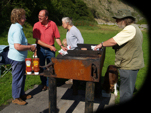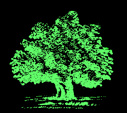|
Back to the 150th Anniversary index
Go Back to last page visited
We do not have an obituary for Victor Earle Nash-Williams, but there is a summary of his works in Volume XCIV of the Transactions in 1968 from which some excerpts: -
After Wheeler's remarkable success in systematising Roman archaeology in Wales, work on this period was continued by V. E. Nash-Williams (later Dr.), a native of Fleur-de-Lys, Monmouthshire, and a graduate of Cardiff, who was appointed Assistant Keeper of Archaeology at the National Museum in 1924 and became Keeper two years later.
As a classical scholar, Nash-Williams was conscious of the great cultural contrast between the Celtic Iron Age people and the Romans, whom he saw as the harbingers of the Early Christian period. His work at the Iron Age fortifications of Sudbrook and Llanmelin in Monmouthshire was important in showing the relationship between native and Roman early in the Roman invasion.
Nash-Williams became especially identified with Roman Caerleon. Backed by the Ministry of Works, the Museum and the College, he conducted many excavations. It was he who brought to light the foundations of the west corner of the fortress in the Prysg field, which are today preserved by the Ministry for the public to visit. When the Caerleon Museum was transferred to the ownership and care of the National Museum in 1930, he became responsible for it as a branch archaeological gallery.
During the campaigning season, like a latter-day Julius Frontinus, he would sit in his tent at Caerleon majestically dictating letters to his secretary. In 1954 he was on the threshold of what he hoped would be the crowning achievement of his work there, the exploration of the civil settlement outside the fortress. The project came to a premature close owing to Nash-Williams' sudden death, but not before enough had been discovered to prove the existence of a settlement and to give some idea of its layout.
Nash-Williams' major work in the Roman field was The Roman Frontier in Wales (1954) a 'severely factual' catalogue of the Roman military sites in Wales and an attempt to show how they were organised in terms of strategy. He was interested also in the civil aspects of the Roman occupation. He re-opened the villa site at Llantwit Major, and not only recovered the whole plan but also elucidated the sequence of building. The numerous skeletons which had aroused so much interest in John Storrie's time were shown to represent a late phase in the occupation when part of the villa was in ruins and used as a cemetery.
At Caerwent, the principal Roman civil site in Wales, much excavation had gone on during the early years of this century under the auspices of the Caerwent Exploration Fund and Committee, set up in 1899 under the first Lord Tredegar. The plans of many buildings were recovered, but unfortunately little attention was paid to stratification. Nash-Williams dug several sites at Caerwent, and summarised the state of knowledge in his Presidential address to the Cambrian Archaeological Association at Chepstow in 1953.
A noteworthy practice in his work at Caerwent, as well as elsewhere, was to commission the artist Alan Sorrell to make pictorial reconstructions depicting the place as it might have been under the Romans.
in a biography in the Dictionary of Welsh Biography, it notes: -
He spent his entire professional career in the service of the National Museum of Wales and of the University College , Cardiff . When Mortimer Wheeler whose early pupil he was, became director of the National Museum in 1924 , Nash-Williams was offered the Assistant Keepership of the Department of Archaeology under Cyril Fox (see above) ; and when Fox in his turn became Director , Nash-Williams became Keeper of the department and also lecturer in archaeology at the College, a post conjoint with the keepership since Wheeler's arrival in 1920. He served in both World Wars (infantry, 1915-19 ; R.A.S.C. and latterly as Major in the Historical Section of the War Office, 1940-45).
The latter of these is noted in Volume LXXII - LXXVIII of the Transactions in 1945
PRESIDENT. Dr. V. E. Nash-Williams, who was elected President for the 1939/40 Session, was unfortunately unable to complete his Presidential duties, owing to his service with the Forces. The Council has therefore invited him to accept nomination as President for the 1945/46 Session, and he has kindly agreed to do so.
As the societies activities were suspended for much of the war his period of office shows from 1939-45 in our records
A monument to his efforts can be seen at the Roman Legionary Museum in Caerleon. A memorial inscription on bronze, now facing the great imperial inscription of AD 100 which he himself discovered, reads: -
IN Memory of
VICTOR ERLE NASH-WILLIAMS
1897 1955
For twenty-nine years Keeper of Archaeology in
the National Museum of Wales, and director of many
excavations in the Roman Legionary fortress of Isca.
He was gracious in life, exact in scholarship,
fearless in advocating what he believed to be truth,
unfailing in friendship, and selflessly helpful to
his colleagues, his staff, and his students.
Back to the 150th Anniversary index
Before this... Frank Bird M.Sc (?-1968/9) 66th President
Next up... Henry John Randall, LL.B., F.S.A (1877-1964) 68th President
See our Full list of Presidents
These pages are part of the Cardiff Naturalists' Society 150th Anniversary celebrations and are about our history and are celebrating the people who developed our Society and helped build the city and the cultural heritage of Cardiff. You can read more about that using the links above
If you want to read about the ways we study the wildlife and environment of the Cardiff area and its surroundings, and about the talks we have about the wildlife of the world, and find the programme of talks, walks and other events that we do then please take a look at our main website, our blog and our facebook and twitter feeds for up to date news
|

